Bunker spoons often catch the largest striped bass in a given area. If you want to target the cows, then consider trolling spoons.
I first trolled bunker spoons off Cape Cod when I was 18 or 19 years old. Most of the stripers I have caught trolling bunker spoons have weighed at least 25 pounds, with the largest 43 pounds.
In this post I will share with you my super simple approach for getting started trolling bunker spoons off Cape Cod.
Bunker Spoon Trolling Rods and Reels
You’ll need some specific equipment to get started trolling bunker spoons. Using the right tackle will help you fish the spoons correctly, and get the spoons down deep where the big fish normally are.
For reels I have always used the Penn 113HSP.
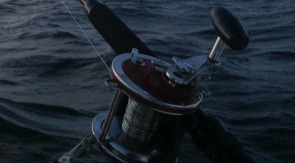
The Penn 113HSP is built for wire line trolling and jigging. I also use these reels for trolling with lead core line. The Penn 113HSP has been used all over Cape Cod and the Islands for many years.
Rod selection is also pretty important when trolling bunker spoons for stripers. The best rod for trolling spoons is normally around 8ft long, with a supple tip and plenty of backbone.
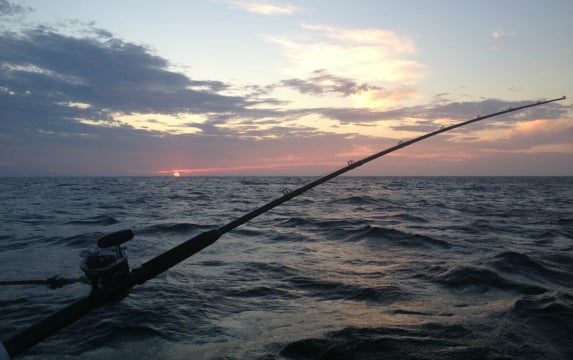
On my boat I use an 8' Cape Cod Rod Company bunker spoon trolling rod, as well as a 7'6'' Tsunami bunker spoon rod. Both rods do a nice job of helping to impart the correct fish-attracting "wobble" action of the spoon.
Wire Line, Backing and Connections
If you are in the Cape Cod area, then the easiest way to get your reels loaded up for bunker spoon trolling is to have the crew from the Goose Hummock Shop in Orleans take care of it for you.
If you plan on loading the reels yourself, then here is what's worked for me in the past.
Recommended Bunker Spoons
There are several different types of bunker spoons available on the market. The Tony Maja series of bunker spoons are extremely popular down south and I am sure they will work here on Cape Cod.
The Maja spoons were not available when I first started trolling for striped bass, so I tend to stick to Reliable Bunker Spoons. I’ve had success with white, metallic and green colored Reliable spoons.
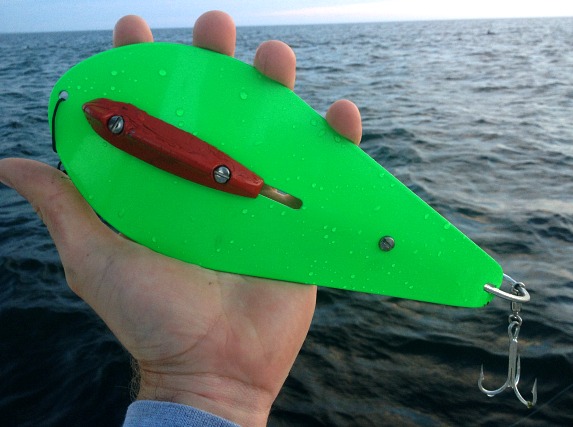
The theory behind the green spoons is that it imitates an injured Atlantic mackerel, which sometimes turn greenish in color when being pursued by stripers. I keep the keel positioned forward, which is how the spoon comes from the factory.
The Bunker Spoon Trolling Technique
I enjoy trolling spoons because it’s simple and does not burn a lot of gas.
I usually put all 300 feet of wire line into the water, which brings the spoons down to around 30 feet. 20-30 feet down is where I normally find suspended striped bass when trolling depths of 40 – 80 feet.
I set the drag to 9 pounds and I troll around 3mph. The bunker spoon rod will “pump” when the spoons are swimming correctly. Correctly swimming spoons flutter about 2 feet to the left, then 2 feet to the right, in a rhythmic motion.
That is the general gist of trolling spoons. I told you it was relatively simple! The most challenging part of course is finding an area with life (striped bass and bait) in which to troll.
Good Spots on Cape Cod to Troll Bunker Spoons
I only troll spoons in wide open areas-never in creeks or channels. I feel my odds are best when trolling areas where there may be pogies, mackerel, sea herring or other “big bass bait” around.
The bunker spoon is meant to imitate a large solitary injured bait fish, such as a bunker (we call them pogies) which has lost the relative protection of traveling within a tight knit school of other large bait fish.
One example of a good tract of water in which to troll spoons is a place where schools of large bait are dotting the surface. For instance, on flat calm days, mackerel schools can be relatively easy to spot in places like Cape Cod Bay.
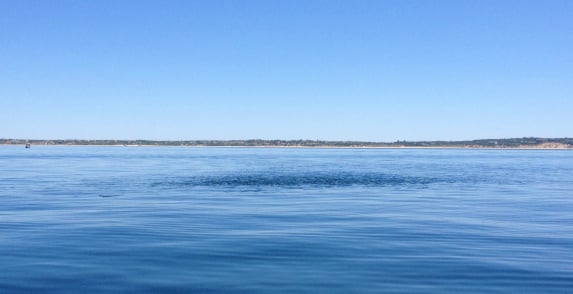
I general, I normally troll spoons a mile or more offshore (with some exceptions), and not in a protected cove or harbor. There is a lot of water out there and I help increase my odds by focusing on spots that contain an active ecosystem with big bait.
Even if you are not marking schools of stripers, as long as you are marking big bait, you’ll have a good chance at finding a rogue striped bass or two.
Sometimes real big stripers hang out by themselves in these deep water areas. So if you are marking bait but not marking bass, there could still be some behemoth singles cruising around by themselves.
Often times I will catch a big bass on the bunker spoon, even though I have not marked a single fish on my sonar. You might get just one bite all day, but odds are it’ll be a fish worth taking a photo of.
More Ways to Catch Stripers from your Boat off Cape Cod
Way back on January 17th of 2015 I held in-person fishing classes at Bass Pro Shops in Foxboro, and one of the topics we discussed was "Fishing the Cape by Boat."
During that class (which lasted 70 minutes!) we talked about specific techniques and strategies, places fish gather and how to find really big striped bass using your sonar.
We covered a lot, broken down into these 4 general categories:
- Spots on Cape Cod to find stripers in your boat
- How to find striped bass using your sonar and other tools
- Techniques that work best for stripers in specific areas
- Night fishing from your boat
I recorded the entire 1 hour 10 minute long session and MFCC members can watch the entire presentation by clicking below.
In Conclusion
Bunker spoon trolling is not for everyone, because sometimes there are long waits in between bites. Plus not everybody enjoys trolling as many people prefer to cast lures, which is of course perfectly fine.
Nevertheless there is something to be said about simply putting a line behind the boat and trolling along. Trolling spoons can be a relaxing way of spending a morning on the water. In addition the drag screaming strike of a big fish on a spoon is not something you'll forget!
As always I hope you enjoyed this article. I am not a bunker spoon trolling expert but I try my best. I hope you found the tips in this blog post to be of good value, and please let me know what you think by commenting below.
Tight lines!


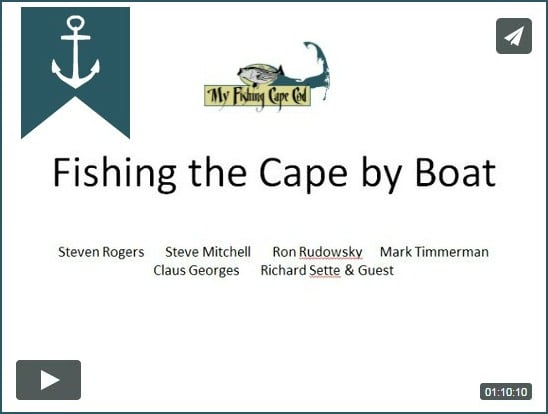


Good Morning MY Fishing Cape Cod members . After reading what i had posted recently, I determined that I had forgotten to also add something that can be an extra hanger of fish when they hit and that is to add a stinger hook , stainless steel at least 10/0 in size to the treble . Also another tip is that when the tuna are in the bay to make sure your combination is really secured for they are well known to attack a spoon inside Cape Cod Bay over the years . If the reels drag is to tight you could well lose all when they strike or you could have a nice fight . Peace and Prayers
Good tip Carl, especially about the bluefin tuna. Every year you hear about someone getting spooled. Thank you!
Ryan, I’m attempting to watch the “Fishing the Cape by Boat” video put it says that due to privacy settings it won’t play. I’m a member and logged in. Any idea what the issue is for me. I’ve had this issue recently on other videos. Thanks, John
Hey John, thanks for reaching out about the issue. I just took a look and everything is playing properly for me. However, let me email you a direct link to the video. That should work. I will send you a message right now. Thanks again for the comment!
Good Morning My Fishing Cape Cod posters. Above is a very well tutorial on Bunker spoons by Ryan . Having undergone many a trip where we used bunker spoons with great success for large fish I would like to add that the choice of reels and settings mentioned above will help in the catch department and not the loss of fish when they strike.
I would also suggest that the Handle be changed to the off set one, instead of the one it comes with. It will make the battle much easier in the end, especially if you let out all of the wire from the reel . They are custom made for this reel and will be in the 50 to 60 dollar range . I would also Sus jest that you have two secure lines one for each rod setup attached securely to the boat .
Use brass clipps that you secure to the reel open tie if you were doing stand up fighting and long enough to allow you to take the rod out of the holder and engage the fish before un clipping.
Another type of rod holder also can be employed so that you can swivel the rod straight up in the air and then remove the rod in an upward motion, rather then reaching out across the gunnel to pull the rod out. When you nail fish 30 to 50 pounds they will apply a great deal of pressure against the rod holder and make it rather difficult to remove it and fight the fish.
If you use five gallon buckets[use a three-way tie to the bucket it self ]to slow the boat down to the proper speed , make sure they are tied to the most forward cleat , so when the boat comes to a stop the buckets are not in your way as you fight the fish . WE often would run the beach going from the beach to some location 30 feet to some location in the deeper water and then reverse the same numbers and head back in. Spooning in a line parallel with the beach in 40 feet of water also has proven to be very successful. Should you go over a school of fish and they have closed mouths , Put the motor in Neutral , give a count of at least 10 and reengage. This is one place where if you have enough depth under you, you can increase the count.
Day Break is one of the very best times to have a spoon in the water , especially when you see pogies on top being chased by feeding fish . Given that today you are limited to what you can keep , make sure you have a net large and deep enough to cradle a fish of size as you lift the fish into the boat to remove the hook. This is where a good pair of long nose pliars come in handy in unhooking the fish and getting back into the water in a speedy fashion. Peace and Prayers
Great comment Carl, thank you!
I love trolling spoons and pretty much only use maja in white or green fishing raritan bay. One issue I encounter is a lot of missed strikes on the spoon where the fish will swat at the spoon and not come tight. Do you have this issue as well? I have seen people add swinging trebels as a trailer to the single hook but not a fan of this especially with the regs. Any recommendations?
Hey Robert – Yes I have definitely missed fish on the spoons, no doubt about that. The spoons I use came with the swinging treble hooks and I do agree it helps hook more fish. However like you mention it probably does more damage to the fish too, which with the new regulations isn’t all that ideal. Right now I don’t have any specific recommendation for you, but if something comes to me then I’ll reply back here and let you know. ?
Hi Robert,
I typically use the larger spoons and troll them at a speed that causes the rods to flex back and forth about a foot. Also, I attach two swivels to the spoons to increase the action. Are you seeing the fish swat at the spoons? If your spoons are visible on the surface you may be trolling them too fast. I have my best luck when fishing them deep.
Hi Ryan,
Great post! I use three different sizes of Maja spoons and have caught many large bass and blues with them over the years. I have found that when the fish are not biting they sometimes cannot resist the bunker spoons. I prefer the stainless steel (unpainted) version over the the colors and usually fish them with lead core. If I mark fish deep, I will slow the boat to a crawl to let the spoons sink and then resume a slow troll. I have had good luck at the fingers off Barnstable, but as said in other posts, you may fish for a while before you catch a fish, but they are often larger fish. The larger hooks combined with the shape of the spoon will sometimes wear a hole in the mouth of the fish, so keeping pressure on the fish is important with these lures. I also use E-Z OutRodders to help prevent crossed lines and because they seem to add some action to the spoons. Tight lines!
Thanks for the tips John! I appreciate it. I’m also intrigued that you are able to fish your spoons on leadcore as I have always used wire. I’m still always learning something new. Thank you and tight lines! ?
Hello Ryan,
Bruce, who ran Reliable for many years retired about 6 months ago. He was going to just shut down Reliable Spoon. I, being foolish, bought what there was of the company and we are making spoons again. We will be ready to start shipping in a few weeks. I would love to get some feedback from you and your readers…..can we run a contest of some kind? I am looking for photos of fisherman and woman with Stripers they have caught with our spoons…..I can put up 10 spoons as prize (thats worth about $450). Let me know any other ideas you have. I know our spoons work….but not many people know about them even after 45 years!
Hey Richard ?Yes your spoons definitely work! They are the only ones I’ve ever used.
Sure I’d be happy to do a giveaway/contest of some sort. Would you be able to email me at [email protected] and we can discuss the details?
Thanks Richard!!!
I use down riggers to get my bunker spoons to the exact deapth I want them at. I use a flexible snubber to get the presentation I am looking for. I am able to use a lighter rod and reel with mono or braid, which my fishing partners and myself find more fun fighting the fish. If I am by myself I find it easier to keep on trolling for a double up. If I feel the fish I have on is worthy of shifting to neutral I rarely have a problem with my second rod behind the boat. When I have someone with me I also will fish two extra setups in a traditional method of trolling with my rod holders so I can also pull different baits or extra spoons, depending who is with me and how fast the action is. Bunker Spoons = Big Stripped Bass, no doubt. How fast I am trolling can be very important.
Have a nice winter.
Rich Caisse
Great comment Rich. You have the technique down to a science. Terrific post and thanks for chiming in!
I bet fighting bass is much more fun using the light setup. It can feel like hard work retrieving all that wire…
Hey Ryan, thanks for this post.
I researched wire line rods and reels for some time before I “gifted” a pair to myself from Santa this year. I ended up with the exact rod you fish. I was looking hard for an alternative to the Penn 113 (because I’m a shimano guy) and wanted to stick with what works. But apparently, Penn’s work hands down the best with wire. The Shimano Tekota was recommended, but it has a level wind that would get shredded with the wire.
I also bought the Cape Cod Rod company striper rods that are made for trolling wire. They have carbide rod guides, (which are critical) and the rods also have a roller tip. I can’t wait to fish them!
I bought from Red Top and the guys were really helpful.
Hope this helps!
Sounds terrific John, nothing wrong with treating yourself to some new fishing gear.
I got my rods from Red Top as well. Nice selection over there. Seems like the Penn 113 (like you mention) is the go-to for wire line, whether its bunker spoons, jigging or something else.
Keep me posted this season, I hope you get a 50!
Best,
Ryan
Hey John,
The Shimano TLD 20 lever drag reels have worked great for wire in my experience, although they are a little more money, but as we can all agree, the senator 113’s really are the work horses of the wire line game. I picked up a pair of Torium 30’s i am going to be using for leadcore this season. big fan of the 6.2:1 gear ration they offer
Nice read Ryan, Can wait to get out to try this out. Thanks! Sorry I missed your seminar at Bass Pro, been so busy with the baby. Hopefully next time!
Nice Rob keep me posted when you catch a nice one on a spoon this season.
Congrats on the baby! That is awesome.
Watching a blizzard and reading up un bunker spoons, life is good.
Life is good Art, stay warm!
Hey Ryan: Great post as usual. I use Bunker spoons exactly as you do, but I’m reluctant to have two lines out when I’m by myself. What do you do when you get a hit (assuming, as the video seems to suggest, that you were by yourself) ? Do you keep the boat in gear and reel in the other line or play the fish and hope it doesn’t swim into the other line? I know a lot of charter boats just keep on going and let the angler drag a fish in, but there’s no way I ever want to do that especially if it’s a halfway decent sized fish. I always put the engine in neutral while playing a fish. Not trying to sound superior or anything just my preference.
Hey Joe, good to hear from you.
Getting a tangle with leadcore or wire really stinks, but if I am by myself and I’m over a school of fish, I tend to try to keep the boat moving forward in an attempt to double up, and make the most of the situation.
I’ll shift into forward, neutral, forward, neutral etc. and try to keep the hooked fish off to one side of the boat – away from the other line – while still trying to actively fish the other line and generate a second bite.
But sometimes the fish or sea conditions make doing that difficult. In those moments I’ll just let that other line drop to the bottom, fight the fish in neutral, and pray for the best!
Excellent instructions on the use of a spoon for stripers. Tom
Hey Tom, glad you found the post useful
Best – Ryan
Ryan who has either the Cape cod bunker rod or the Tsunami?
I got them both at Red Top Sporting Goods in Buzzard’s Bay. Last I checked they still had both in stock.
Ryan: This is interesting, thanks for posting about it. I know it is a popular method in Long Island but I don’t hear about it up here much. I look forward to hearing about it goes.
I hate to have to get my wire set up going again but it is the best way to get your bait down in the water column.
Yep seems like wire is definitely the best way to go Chris.
I trolled spoons for a solid day and hooked up once with a big fish, but dropped him before I was able to get him to the boat.
It happens!
Could you use leadcore instead of wire?
Hi Mike! I’ve tried leadcore before and the spoon came to the surface.
The spoon needs to stay down in the water column, which is the main purpose of the wire.
Ryan, what is the downside of using 65 lb braid instead of wire? I hate dealing with wire and just took it off my Penn Senator as a result. Do I need to add some weight to my tackle to offset the use of the lighter braid?
The wire sinks and helps get the bunker spoon down in the water column. During the summer a lot of big bass like to hang between 20-40 feet down beneath the surface.
Because braid doesn’t sink, you would definitely need to use weight when trolling bunker spoons on braid, I would think, if you want to get the spoon down to 20-40 feet.
Maybe a drail sinker 5 feet up the leader from the spoon. You’d have to figure out the depth ratio thru trial and error. Metered braided line may help with this because it’s marked, so you know how much line you have in the water.
Here’s some examples (I have not personally purchased through these sites):
Metered braided line – http://www.tackledirect.com/powerpro-depth-hunter-braided-fishing-line.html
Drail sinkers – http://www.sharkrivermailorder.com/c175.html